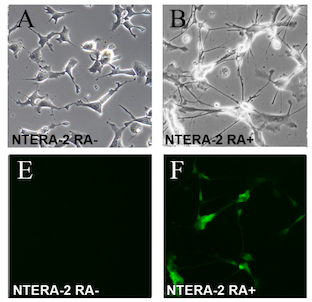Top Qs
Timeline
Chat
Perspective
NTERA-2
From Wikipedia, the free encyclopedia
Remove ads
The NTERA-2 (also designated NTERA2/D1, NTERA2, or NT2) cell line is a clonally derived, pluripotent human embryonal carcinoma cell line.[1]

Characteristics
NTERA-2 cells exhibit biochemical and developmental properties similar to the cells of the early embryo, and can be used to study the early stages of human neurogenesis. The cells exhibit a high nucleo-cytoplasmic ratio, prominent nucleoli, and the expression of the glycolipid antigen SSEA-3. They also express nestin and vimentin, which are found in neuroepithelial precursor cells, as well as microtubule-associated proteins expressed in human neuroepithelium.[2] NTERA-2 cells also accumulate cytoplasmic glycogen.[3]
Remove ads
Differentiation
NTERA-2 cells differentiate when exposed to retinoic acid and lose expression of SSEA-3. Differentiation produces neurons via asymmetric cell division, and these cells form interconnected axon networks and express tetanus toxin receptors and neurofilament proteins.[4] By 10–14 days of exposure to retinoic acid, NTERA-2 cells begin to take on the morphological characteristics of neurons, such as rounded cell bodies and processes.[2] NTERA-2 cells can also produce a small number of oligodendrocyte-type cells, but they cannot differentiate into astrocytes.[5]
Remove ads
Research
Because of their similarity to human embryonic stem cells, NTERA-2 cells are used to study the dopaminergic differentiation of neuronal precursor cells.[6] They have also been proposed as an in vitro test system for developmental neurotoxicity.[7]
History
NTERA-2 cells were originally isolated from a lung metastasis from a 22-year-old male patient with primary embryonal carcinoma of the testis. The tumor was xenografted onto a mouse, and from this cells were cloned into the NTERA-2 cell line.[3]
References
External links
Wikiwand - on
Seamless Wikipedia browsing. On steroids.
Remove ads
